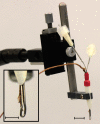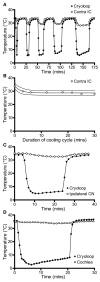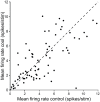Deactivation of the inferior colliculus by cooling demonstrates intercollicular modulation of neuronal activity
- PMID: 23248587
- PMCID: PMC3522070
- DOI: 10.3389/fncir.2012.00100
Deactivation of the inferior colliculus by cooling demonstrates intercollicular modulation of neuronal activity
Abstract
The auditory pathways coursing through the brainstem are organized bilaterally in mirror image about the midline and at several levels the two sides are interconnected. One of the most prominent points of interconnection is the commissure of the inferior colliculus (CoIC). Anatomical studies have revealed that these fibers make reciprocal connections which follow the tonotopic organization of the inferior colliculus (IC), and that the commissure contains both excitatory and, albeit fewer, inhibitory fibers. The role of these connections in sound processing is largely unknown. Here we describe a method to address this question in the anaesthetized guinea pig. We used a cryoloop placed on one IC to produce reversible deactivation while recording electrophysiological responses to sounds in both ICs. We recorded single units, multi-unit clusters and local field potentials (LFPs) before, during and after cooling. The degree and spread of cooling was measured with a thermocouple placed in the IC and other auditory structures. Cooling sufficient to eliminate firing was restricted to the IC contacted by the cryoloop. The temperature of other auditory brainstem structures, including the contralateral IC and the cochlea were minimally affected. Cooling below 20°C reduced or eliminated the firing of action potentials in frequency laminae at depths corresponding to characteristic frequencies up to ~8 kHz. Modulation of neural activity also occurred in the un-cooled IC with changes in single unit firing and LFPs. Components of LFPs signaling lemniscal afferent input to the IC showed little change in amplitude or latency with cooling, whereas the later components, which likely reflect inter- and intra-collicular processing, showed marked changes in form and amplitude. We conclude that the cryoloop is an effective method of selectively deactivating one IC in guinea pig, and demonstrate that auditory processing in the IC is strongly influenced by the other.
Keywords: auditory pathways; auditory processing; commissure; cooling inactivation; guinea pig; inferior colliculus; single unit.
Figures












Similar articles
-
Commissural Gain Control Enhances the Midbrain Representation of Sound Location.J Neurosci. 2016 Apr 20;36(16):4470-81. doi: 10.1523/JNEUROSCI.3012-15.2016. J Neurosci. 2016. PMID: 27098691 Free PMC article.
-
Intercollicular commissural connections refine the representation of sound frequency and level in the auditory midbrain.Elife. 2014 Nov 18;3:e03764. doi: 10.7554/eLife.03764. Elife. 2014. PMID: 25406067 Free PMC article.
-
Cooling of the auditory cortex modifies neuronal activity in the inferior colliculus in rats.Hear Res. 2016 Feb;332:7-16. doi: 10.1016/j.heares.2015.10.021. Epub 2015 Nov 26. Hear Res. 2016. PMID: 26631689
-
Neural interactions in unilateral colliculus and between bilateral colliculi modulate auditory signal processing.Front Neural Circuits. 2013 Apr 19;7:68. doi: 10.3389/fncir.2013.00068. eCollection 2013. Front Neural Circuits. 2013. PMID: 23626523 Free PMC article. Review.
-
Corticofugal modulation of peripheral auditory responses.Front Syst Neurosci. 2015 Sep 30;9:134. doi: 10.3389/fnsys.2015.00134. eCollection 2015. Front Syst Neurosci. 2015. PMID: 26483647 Free PMC article. Review.
Cited by
-
Time-sensitive reorganization of the somatosensory cortex poststroke depends on interaction between Hebbian and homeoplasticity: a simulation study.J Neurophysiol. 2014 Dec 15;112(12):3240-50. doi: 10.1152/jn.00433.2013. Epub 2014 Oct 1. J Neurophysiol. 2014. PMID: 25274347 Free PMC article.
-
Midbrain local circuits shape sound intensity codes.Front Neural Circuits. 2013 Oct 30;7:174. doi: 10.3389/fncir.2013.00174. eCollection 2013. Front Neural Circuits. 2013. PMID: 24198763 Free PMC article.
-
Investigation of Neuron Latency Modulated by Bilateral Inferior Collicular Interactions Using Whole-Cell Patch Clamp Recording in Brain Slices.Neural Plast. 2021 Dec 10;2021:8030870. doi: 10.1155/2021/8030870. eCollection 2021. Neural Plast. 2021. PMID: 34925502 Free PMC article.
-
Acute Inactivation of Primary Auditory Cortex Causes a Sound Localisation Deficit in Ferrets.PLoS One. 2017 Jan 18;12(1):e0170264. doi: 10.1371/journal.pone.0170264. eCollection 2017. PLoS One. 2017. PMID: 28099489 Free PMC article.
-
Auditory Processing in Noise: A Preschool Biomarker for Literacy.PLoS Biol. 2015 Jul 14;13(7):e1002196. doi: 10.1371/journal.pbio.1002196. eCollection 2015 Jul. PLoS Biol. 2015. PMID: 26172057 Free PMC article.
References
LinkOut - more resources
Full Text Sources

